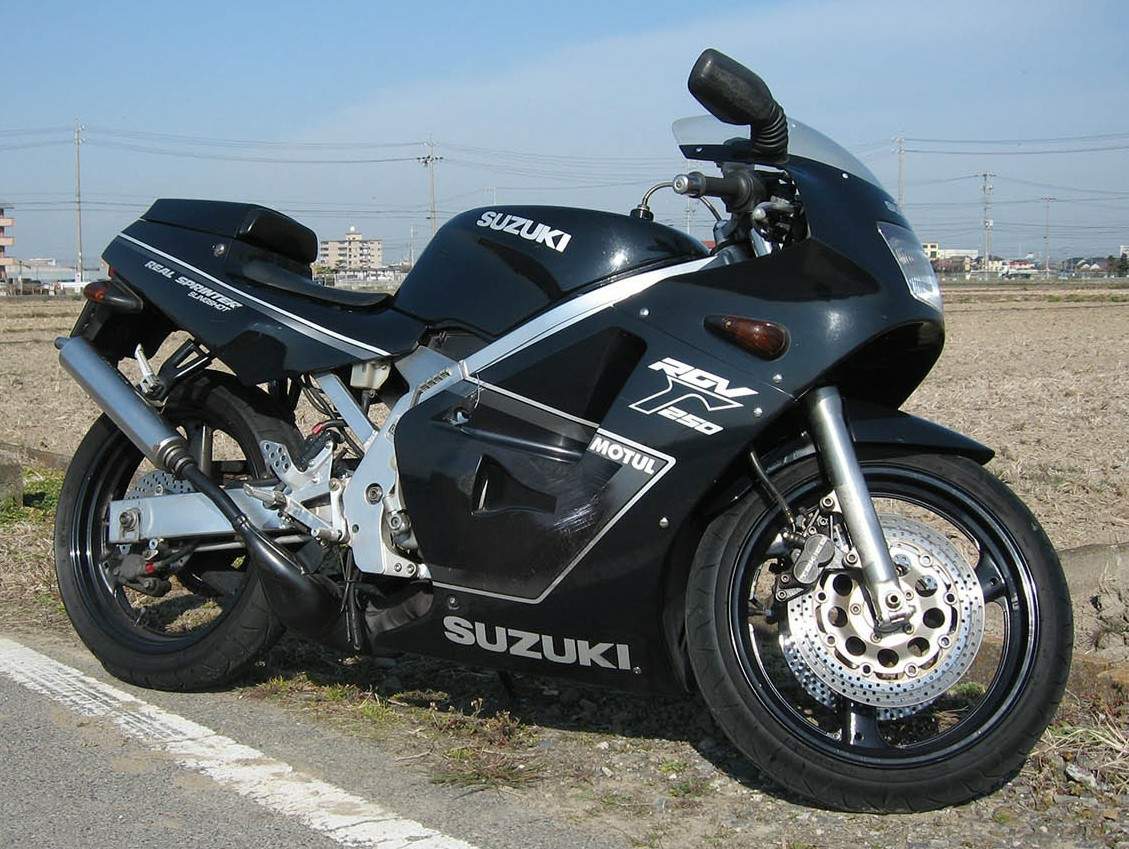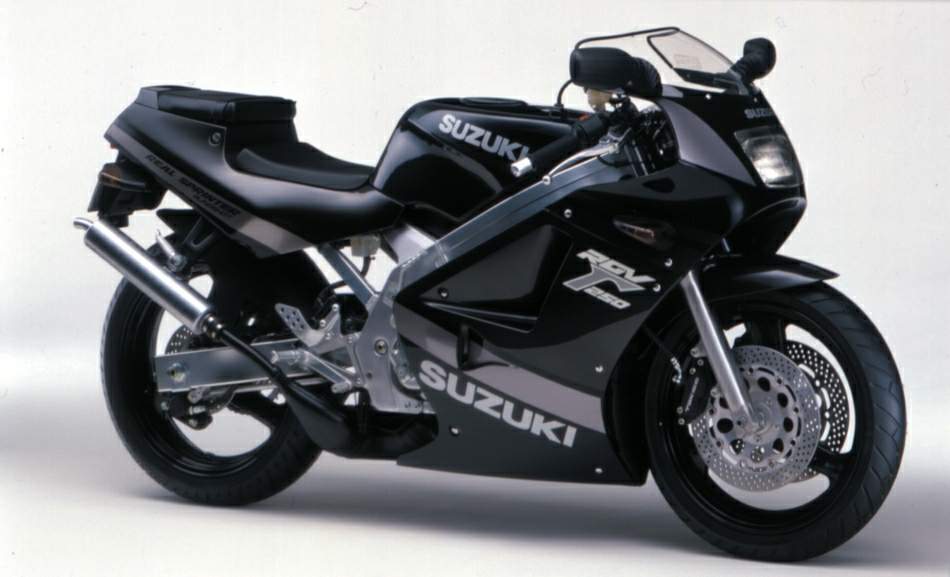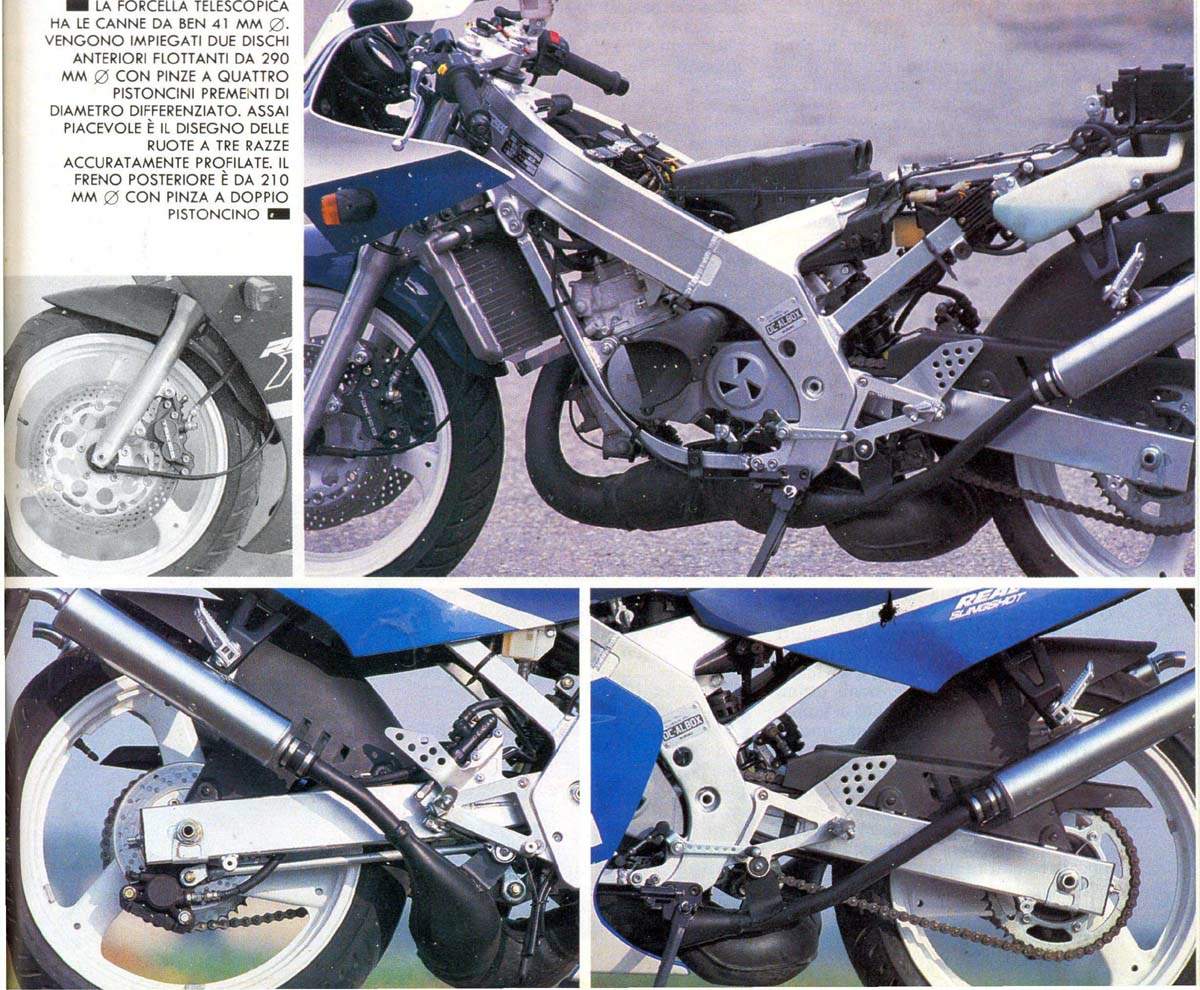
|
|
|
|
|
|
Classic Bikes
Custom Bikes
Individual
Racing Bikes AJP
AJS
Aprilia
Ariel
Avinton / Wakan
Bajaj
Benelli
Beta
Bimota
BMW
Brough Superior
BRP Cam-Am
BSA
Buell / EBR
Bultaco
Cagiva
Campagna
CCM
CF Moto
Combat Motors
Derbi
Deus
Ducati
Excelsior
GASGAS
Ghezzi Brian
Gilera
GIMA
Harley Davidson
Hero
Highland
Honda
Horex
Husaberg
Husqvarna
Hyosung
Indian
Jawa
Kawasaki
KTM
KYMCO
Laverda
Lazareth
Magni
Maico
Mash
Matchless
Mondial
Moto Guzzi
Moto Morini
MV Agusta
MZ / MuZ
NCR
Norton
NSU
Paton
Peugeot
Piaggio
Revival Cycles
Roland Sands
Royal Enfield
Sachs
Sherco
Sunbeam
Suzuki
SWM
SYM
Triumph
TVS
Ural
Velocette
Vespa
Victory
Vincent
VOR
Voxan
Vyrus
Walt Siegl
Walz
Wrenchmonkees
Wunderlich
XTR / Radical
Yamaha
Zero
Video
Technical
Complete Manufacturer List
|
Suzuki RGV 250
|
| . |
|
Model. |
Suzuki RGV 250 |
|
Year |
1989 |
|
Engine |
Two stroke, 90° V- twin, reed valve |
|
Capacity |
249 cc / 15.2 cu in |
| Bore x Stroke | 56 x 50.6 mm |
| Compression Ratio | 7.5 :1 |
| Cooling System | Liquid cooled |
|
Induction |
2 x Mikuni VM32SS semi-flat carburetors |
|
Ignition |
Pointless Electrical Ignition |
|
Spark Plug |
NGK BR9ES |
|
Battery |
12V, 5Ah |
|
Starting |
Kick |
|
Max Power |
35.7 kW / 49 hp @ 9500 rpm |
|
Max Torque |
40 Nm / 4.1 kgf-m / 29.5 lb-ft @ 8000 rpm |
|
Clutch |
Wet, multi-plate |
|
Transmission |
6 Speed, constant mesh |
|
Primary Reduction |
2.565 (59/23) |
|
Gear Ratios |
1st 2.454 (27/11) / 2nd 1.625 (26/16) / 3rd 1.235 (21/17) / 4th 1.045 (23/22) / 5th 0.916 (22/24) / 6th 0.840 (21/25) |
|
Final Drive |
Chain, DID520V2, 114 links |
|
Front Suspension |
Telescopic fork, 5-way adjustable with anti-dive, oil dampened |
|
Front Wheel Travel |
120 mm / 4.7 in |
|
Rear Suspension |
Full Floater, mono-shock, gas/oil damped, 7-way adjustable |
|
Rear Wheel Travel |
140 mm / 5.5 in |
|
Front Brakes |
2 x 290 mm Discs ,4 piston calipers |
|
Rear Brakes |
Single 210 mm disc, 1 piston caliper |
|
Front Tyre |
110/70-17 |
|
Rear Tyre |
140/60-18 |
|
Frame |
Twin spar, aluminium |
|
Rake |
26o |
|
Trail |
110 mm / 4.3 in |
|
Dimensions |
Length: 2015 mm / 79.3 in Width: 695 mm / 27.4 in Height: 1065 mm / 41.9 in |
|
Wheelbase |
1375 mm / 54.1 in |
|
Ground Clearance |
120 mm / 4.7 in |
|
Seat Height |
755 mm / 29.7 in |
|
Turning Radius |
3.1 m / 10.2 ft |
|
Lean Angle |
58° |
|
Dry Weight |
128 kg / 282 lbs |
|
Fuel Capacity |
17 Litres / 4.5 US gal / 3.7 Imp gal |
|
Oil Capacity |
1.1 Litres / 12 US qt / 1.0 Imp qt |
|
Consumption Average |
7.8 L/100 km / 12.8 km/l / 30 US mpg / 36.0 Imp mpg |
|
Standing ¼ Mile |
12.9 sec / 160 km/ / 100 mph |
|
Top Speed |
202 km/h / 125 mph |
|
Road Test |
Motosprint 1989 |

Nobody needs reminding what the current legislation regarding learners did to the British 250cc motorcycle market. And although punitive legislation here and in the pipeline is still a bugbear with learners, there.is a silver lining to the cloud in the shape of the super hot 250cc machines the Japanese importers are now bringing in to answer spiralling big bike insurance costs.
Had I not just ridden the RGV250, I might also have said that many people do enjoy riding a bike to its limits, and who can do that with a l000cc megabike. The thing is, you might be pushed to find the limits of this 250cc gem from Suzuki on the public highway.
Whatever reason you accept for the arrival of the RGV250, this machine is a work of art, good enough for showing at the Tate. Closer scrutiny makes one call to mind Swiss precision watches in trying to describe the workings of this machine. Even Suzuki's staff all gazed longingly out of their windows as I collected it, rain teeming down, from their Crawley headquarters.
I am used by now to my first few miles on any machine to be wet ones, and on this occasion they were on a motorway to boot. This moved onto some heavy traffic work, again not an ideal start to an all too brief relationship with this lightweight. The motorway did prove one thing, however, namely that despite showing far too much of the rider's anatomy, the mirrors on the RGV250 do at least remain vibration-free. And although not offering the widest field of rearward visibility, they were enough to spot the pursuing white BMW before things got too embarrassing.
The heavy rain and spray also proved that the blue and white fairing may carve a beautifully slippery path through the air, but it does nothing to protect the rider from the elements, unless you crouch down racing style. This all adds to the spray hitting you at chest level.
Despite being a direct relative of the Grand Prix RGV500 V4, the RGV250 is a surprisingly easy bike to ride. There is no massive step in its power delivery, but instead it has a usable spread of power across the revband. It can be trickled along in traffic, provided you use the lower gears and swap cogs frequently. But this tends to highlight the machine's only flaw the gearbox.
As one expect the gearbox on the RGV250 is a six-speeder of the cartridge variety, whereby(the entire assembly may be removed in one piece, allowing racers to choose the set of ratios they find ideal for different circuits. And let's no be in any doubt about this, the RGV250 is a street-legal racer, not a replica.
The 'box itself is quite clunky, and a shot putter would be proud of its throw between gears. No matter how hard you may try to perfect a clunkless change, it will be in vain, until you reach the top three ratios.' At higher speeds, out on the open road, just keep the throttle open, ignore the cable-operated clutch, and just snick the lever gently upwards with your toe, and changes will be a s smooth as silk.
Maintaining maximum rates of acceleration in town is hardly practical, because one soon finds oneself travelling in excess of three-figure speeds. Downchanges, however, are for some reason no problem at all. Blip the throttle and they will engage sweetly and accurately.

Although the bike has six gears, sixth itself is
really more of an overdrive, having to be disengaged even on gentle motorway
gradients if one is to maintain momentum. Mind you, there are five other gears
lower down, which are more than adequate to facilitate the rapid passing of
queues of traffic. Despite the overall flexibility of the engine, and the lack
of a discernible powerband, the 'box requires attention if you are not to find
yourself lacking the immediacy of throttle response that you may desire.'
Out on the open road is definitely the natural habitat for this machine, if for
no other reason than the sound of its exhaust note. At low speeds the twin
silencers emit a pleasant burble, not too dissimilar to any other two-stroke,
but get the revcounter up to 8,500rpm and it sounds more like a power saw blade
cutting through solid wood.
The sound really makes the adrenalin surge and
encourages the frequent exploration of the upper reaches of the revband, hanging
onto the lower gears for as long as possible just to savour that wonderful
banshee exhaust wail. Who needs aftermarket exhausts with an RGV250?
The exhaust pipes are mounted to the engine by way of a convoluted bellows
arrangement, to prevent metal fatigue due to any vibration. The engine itself is
a ninety degree V-twin unit fitted with reed valve crankcase induction. Bore and
stroke measure 55 and 50.6mm respectively, and the compression ratio created by
the piston displacement of 249cc is 7.5:1. The engine is inclined 20 degrees
forwards to lower the centre of gravity a little and to improve handling.
From their location at the rear of the engine, two Slingshot carbs of 32mm
diameter feed two separate channels of unequal length directly into the
crankcase. Two-strokes are notoriously fuel-inefficient, but in
this case an average consumption rate of one gallon of unleaded fuel every forty
miles necessitates a stop by the rider every 100 miles or so to refill its 17
litre tank. Mind you, by this time, due to the sparsely padded racing-style slab
seat, the rider is probably grateful for a stop anyway. The oil tank for
2-stroke oil is located in the rear seat hump.
In case you should be curious as to what exactly a Slingshot carb' is, I can tell you that it is a slide carb' wherein the slider is flat-sided on the side which faces the air cleaner, but round-sided where it faces the port. This slide is made from a resin compound for lightness. Its design is also claimed to reduce the turbulence of the intake mixture, whilst increasing its volume thanks to the faster flow of gas output from the main jet and the higher negative pressure. After all that, I don't know that I'm much the wiser!
Starting the RGV250 is a pleasingly simple affair. Fully advance the handlebar-mounted choke control, and give a gentle prod on the kickstart lever. It should fire straightaway and may be ridden away immediately. The choke should be backed off as the engine warms, but the temperature gauge itself rarely moves from rest except in heavy traffic.

The large curved radiator which is located across the front of the fairing is in
itself a work of art. Its reservoir balances out the oil tank at the rear of the
machine. Access to both is gained by removal of the pillion pad, held in place
by a key-operated lock. One also finds the toolkit in what little space is left
therein.
To say that the riding position is uncompromising would be an understatement,
and no quarter is given to rider or pillion comfort. In any case, pillion
comfort is hardly going to be a consideration on such a single-purpose machine
as this. This is a bike for riding solo for pure enjoyment
The rider gets only a thin pad for his posterior to
rest on and most of the weight is taken on the wrists. The rearsets are set high
and it's a long way down to the tarmac, although this is not as uncomfortable as
it may sound. At traffic lights though, it pays to sit upright to take the
weight off your wrists momentarily. Despite all this, there is a surprising
amount of room on this bike, and my six feet two inches was not too cramped at
all. Mind you, by the time you are on reserve, you would probably appreciate a
stop anyway.
The frame of the RGV250 is a wholesome-looking twin spar aluminium girder jobbie,
combined with Suzuki's Full Floater monoshock rear suspension. A spanner in the
tool kit is needed to adjust the rear shock absorber, but the rear wheel
needs to be clear of the ground before you can do this, and so it'll need to be
up on a paddock stand, as there is no in-built centrestand.
The eighteen inch rear wheel itself features a
massive 140/60 Dunlop low profile radial tyre and to save weight features three
hollow spokes. The front wheel is an inch smaller in diameter and is shod with a
110/70 item. Wet or dry, the Dunlops offered good grip and gave absolutely no
cause for alarm at any time.
At the front, the forks tubes are 41mm in diameter, with adjustable pre-load. As
is usual. I found that for the majority of riding the middle setting was just
right.
The general handling of the Suzuki's hot 250 is indeed very difficult to fault.
I took this machine down one of my favourite stretches of B-road, which is wide,
has some particularly pleasing series of bends, some tight but others open and
sweeping, it also has a good grippy road surface and it is not used by a lot of
traffic.
I started out at a modest 70mph pace, then since
there was no traffic at all stepped up the pace to a more interesting 95mph. As
I turned around to try this excellent stretch of road the other way, I managed
to
a good I05mph from this little scorcher, a rate of progress in such conditions
that it is hard to achieve on some larger machinery. Much of this is down to the
light weight of the RGV250 — only 282lbs and its ability to make full use
of its 58bhp. If you can find the limits of this bike on the road, you are
either an undiscovered World Champion or well versed in fishermen's tales!
When indulging in such antics as I have just
described, it is comforting to know that the brakes are able to stop you if
necessary. The twin 290mm slotted discs at the front allied to the 210mm single
rear item are a perfect match for the motive power of the engine.
The discs are gripped by the familiar Decca system used by Suzuki, with four
pistons of two different Sizes, staggered to provide smoother, more effective
retardation. The front brake lever itself is also adjustable for reach. Two
fingers are all you will need for the front brake lever, and the rear needs the
lightest of pressure just to steady the bike.
Although obviously intended mainly for track use, Suzuki have not skimped on the
legal niceties, such as lights, horn, indicators, etc. Mind you, the horn is
pretty feeble
and should not be relied upon.
The large curved headlight at the front certainly helps rapid progress after dark with a good spread of beam both on main beam and when dipped. Instrumentation is also good, although there is a lack of electronic frippery, with things kept to the bare essentials, which in itself aids the rapid assimilation of all the important information at a glance. I wish I could find it in myself to justify my status as a critic, by coming up with a few things over which I could sensibly criticise the RGV250. The fact is, however, that apart from the gearbox, this little hotshot is as near the ideal lightweight as one could reasonably ask for.
However, much as we may all wish, we can't all have a hotshot 250 sitting in the garage waiting for the occasional Sunday blast, especially not with a price tag of £3299 — or £3499 with its Pepsi colour scheme. Mind you, when you consider that this is a street-legal machine with all the attributes of a Grand Prix racer, sharing similar facilities to bigger brethren like the RC30 or 0W0I, all for a fraction of the price, then the Suzuki RGV250 could be regarded as a bit of a bargain. Try it if you dare! •
Source Motorcycle News 1989
|
Any corrections or more information on these motorcycles will be kindly appreciated. |